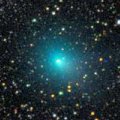
|
Now it is so bright as 7.9 mag (Apr. 17, Juan Jose Gonzalez). It will be observable at 8-9 mag in good condition from April to May. After that, it keeps observable for a long time until when it fades out in the Northern Hemisphere, although it will be low in July.
Date(TT) R.A. (2000) Decl. Delta r Elong. m1 Best Time(A, h)
Apr. 17 20 8.19 48 5.4 1.265 1.435 77 8.2 5:00 (195, 5)
Apr. 24 20 28.45 58 41.9 1.278 1.425 76 8.2 5:05 (190, -5)
|
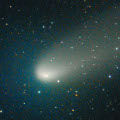
|
Now it is so bright as 9.2 mag (Mar. 20, Marco Goiato). It will be fading gradually after late May. But it keeps observable in a good condition for a long time. It keeps observable until autumn when it fades down to 16 mag.
Date(TT) R.A. (2000) Decl. Delta r Elong. m1 Best Time(A, h)
Apr. 17 14 11.03 -5 6.5 0.685 1.683 170 9.9 0:33 (180, 60)
Apr. 24 14 8.36 -4 50.3 0.704 1.705 172 10.0 0:02 (180, 60)
|

|
It has been unobservable for a while, but now it is appearing in the morning sky. Now it is 10.2 mag, much brighter than expected (Apr. 17, Marco Goiato). It will approach to the sun down to 0.4 A.U. in July, and it is expected to reach up to 2-3 mag. In the Northern Hemisphere, it is observable only until June.
Date(TT) R.A. (2000) Decl. Delta r Elong. m1 Best Time(A, h)
Apr. 17 23 3.24 1 16.3 2.318 1.675 39 11.0 5:00 (255, 19)
Apr. 24 23 15.51 4 27.2 2.140 1.559 42 10.5 5:05 (249, 21)
|

|
It reached up to 7.7 mag in last summer (Aug. 13, Chris Wyatt). It is fading now. It has already faded down to 11.7 mag (Apr. 17, Marco Goiato). In the Southern Hemisphere, it keeps observable for a long time after this. But in the Northern Hemisphere, it is only observable in the low sky in spring, then it will never be observable again.
Date(TT) R.A. (2000) Decl. Delta r Elong. m1 Best Time(A, h)
Apr. 17 20 19.61 -29 56.4 4.062 4.126 86 11.3 5:00 (263, 68)
Apr. 24 20 17.68 -31 13.9 3.975 4.167 93 11.3 5:05 (259, 76)
|
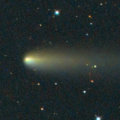
|
It brightened up to 9.5 mag on Jan. 13 (Juan Jose Gonzalez). Now it is fading rapidly. But it is still bright as 11.9 mag (Apr. 10, Carlos Labordena). It will be observable in good condition for a long time after this in the Northern Hemisphere. It keeps visible visually until summer. In mid March, the nuclear fragmentation was observed.
Date(TT) R.A. (2000) Decl. Delta r Elong. m1 Best Time(A, h)
Apr. 17 15 12.80 62 57.8 2.690 3.099 104 12.0 1:34 (180, -8)
Apr. 24 15 6.82 63 37.6 2.771 3.150 102 12.2 1:00 (180, -9)
|
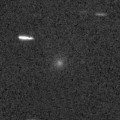
|
Bright new comet discovered at 11 mag in the extremely low sky at dawn. Now it is 10.7 mag (Mar. 27, Juan Jose Gonzalez). It was observed only about one week. It will never be observable again.
Date(TT) R.A. (2000) Decl. Delta r Elong. m1 Best Time(A, h)
Apr. 17 2 4.04 25 13.2 1.562 0.658 16 12.2 18:58 (107,-20)
Apr. 24 2 35.98 21 8.6 1.685 0.725 11 12.7 18:50 (105,-16)
|
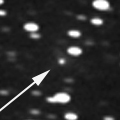
|
Now it is 15.9 mag (Apr. 9, C. Rinner, F. Kugel). It will be getting brighter rapidly in the morning sky. It keeps observable bright as 9-10 mag for a long time from spring to autumn.
Date(TT) R.A. (2000) Decl. Delta r Elong. m1 Best Time(A, h)
Apr. 17 20 3.72 -11 47.1 1.364 1.639 86 12.8 5:00 (224, 60)
Apr. 24 20 23.41 -11 12.8 1.285 1.606 88 12.3 5:05 (218, 61)
|
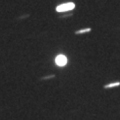
|
Bright new comet discovered as a bright stellar object of 12.5 mag on Apr. 16. It was not detected, fainter than 20 mag, on the previous day (Apr. 15, Catalina Sky Survey). It was discovered just after the sudden outburst. It keeps observable good condition for a while. The coma will be expanding rapidly after this.
Date(TT) R.A. (2000) Decl. Delta r Elong. m1 Best Time(A, h)
Apr. 17 13 38.68 4 46.5 2.094 3.075 164 12.5 0:00 (180, 50)
Apr. 24 13 33.48 4 47.6 2.106 3.073 160 12.5 23:23 (180, 50)
|

|
It became very diffuse with no condensation on Mar. 12 (Hidetaka Sato). This comet seems to disintegrate. Only very faint remnant like a ghost is detected now. However, it is still reported so bright as 10.7 mag visually (Apr. 16, Marco Goiato). In the Northern Hemisphere, it will be too low in early May. In the Southern Hemisphere, it keeps observable for a long time after this, but it keeps locating low.
Date(TT) R.A. (2000) Decl. Delta r Elong. m1 Best Time(A, h)
Apr. 17 4 42.32 20 11.1 1.162 0.843 45 12.7 18:58 (125, 12)
Apr. 24 5 5.47 14 2.7 1.339 0.927 43 12.8 18:50 (121, 16)
|

|
It brightened up to 15.5 mag in January (Jan. 31, C. Rinner, F. Kugel). It is not observable now. The condition of this apparition is bad. It will reach up to 11-12 mag from spring to autumn, but it is not observable.
Date(TT) R.A. (2000) Decl. Delta r Elong. m1 Best Time(A, h)
Apr. 17 1 35.33 16 54.4 2.589 1.597 6 13.0 5:00 (263,-21)
Apr. 24 1 56.24 18 10.5 2.556 1.559 5 12.8 5:05 (261,-19)
|

|
Now it is visible visually at 13.4 mag (Mar. 25, Chris Wyatt). It will brighten up to 12-13 mag in summer. But it locates somewhat low in the Northern Hemisphere.
Date(TT) R.A. (2000) Decl. Delta r Elong. m1 Best Time(A, h)
Apr. 17 20 23.44 -24 58.6 2.340 2.457 84 13.3 5:00 (253, 65)
Apr. 24 20 33.19 -24 59.6 2.262 2.462 89 13.3 5:05 (246, 70)
|

|
Great outburst up to 11 mag occured on Feb. 2. Now it is still bright as 11.7 mag (Apr. 17, Juan Jose Gonzalez). Another new minor outburst occured up to 12.7 mag on Apr. 16 (Albert Sanchez Caso).
Date(TT) R.A. (2000) Decl. Delta r Elong. m1 Best Time(A, h)
Apr. 17 9 16.13 13 23.8 5.781 6.205 110 13.8 19:34 (180, 42)
Apr. 24 9 16.44 13 20.4 5.889 6.207 103 13.8 19:07 (180, 42)
|

|
Bright new comet. Now it is 13.2 mag (Apr. 5, Juan Jose Gonzalez). It will become low in the evening sky very rapidly, and it will not be observable in early May.
Date(TT) R.A. (2000) Decl. Delta r Elong. m1 Best Time(A, h)
Apr. 17 4 44.78 19 41.1 1.696 1.226 45 14.5 18:58 (125, 12)
Apr. 24 5 2.66 15 25.7 1.781 1.251 43 14.7 18:50 (121, 15)
|
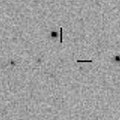
|
It was observed as 15.6 mag at the end of last year (Dec. 6, A. Maury, J. B. de Vanssay, F. Mallia, F. Kugel). It will be 14 mag from winter to spring in 2010. But the condition is bad. Now it is not observable. In the Northern Hemisphere, it will appear in the morning sky at 15 mag in late May, then it keeps observable while fading gradually after that.
Date(TT) R.A. (2000) Decl. Delta r Elong. m1 Best Time(A, h)
Apr. 17 0 56.38 18 57.5 2.770 1.809 13 14.6 5:00 (256,-14)
Apr. 24 1 10.02 22 7.0 2.779 1.835 16 14.7 5:05 (251,-12)
|
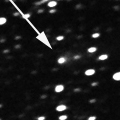
|
Now it is visible visually at 14.5 mag (Mar. 15, Juan Jose Gonzalez). It will be bright as 14-15 mag in spring. It keeps observable for a long time until September when it becomes fainter than 18 mag.
Date(TT) R.A. (2000) Decl. Delta r Elong. m1 Best Time(A, h)
Apr. 17 16 2.36 -30 52.4 0.811 1.712 140 14.9 2:23 (180, 86)
Apr. 24 16 7.15 -30 55.5 0.781 1.712 146 14.8 2:01 (180, 86)
|

|
Not observed in this apparition yet. The condition of this apparition is very bad. It locates in the extremely low sky at dawn only. It will be unobservable after May.
Date(TT) R.A. (2000) Decl. Delta r Elong. m1 Best Time(A, h)
Apr. 17 23 37.51 5 36.2 1.763 1.032 30 15.6 5:00 (256, 9)
Apr. 24 0 9.69 8 50.1 1.715 0.962 28 14.9 5:05 (254, 8)
|

|
The condition of this apparition is very bad. It will go away without any observations.
Date(TT) R.A. (2000) Decl. Delta r Elong. m1 Best Time(A, h)
Apr. 17 2 47.63 15 47.5 2.119 1.200 17 15.1 18:58 (104, -7)
Apr. 24 3 14.89 16 60.0 2.109 1.187 17 15.1 18:50 (106, -6)
|

|
It brightened up to 11 mag in spring and summer in 2009. Appearing in the morninig sky again. It keeps observable after this until autumn when it becomes fainter than 18 mag while fading gradually. But it locates somewhat low in the Northern Hemisphere.
Date(TT) R.A. (2000) Decl. Delta r Elong. m1 Best Time(A, h)
Apr. 17 19 57.12 -24 31.3 2.636 2.825 90 15.3 5:00 (243, 70)
Apr. 24 20 2.48 -24 26.4 2.566 2.850 95 15.3 5:05 (229, 75)
|
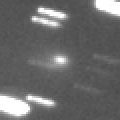
|
It became bright more rapidly than expected. Now it is 14.8 mag (Apr. 6, Catalina Sky Survey). It will be visible visually. It keeps 15 mag for a while. But it will be getting lower gradually in the evening sky.
Date(TT) R.A. (2000) Decl. Delta r Elong. m1 Best Time(A, h)
Apr. 17 5 23.66 32 38.3 1.961 1.629 56 15.3 18:58 (140, 8)
Apr. 24 5 47.69 33 16.6 2.005 1.639 54 15.3 18:50 (141, 8)
|

|
Now it is 15.5 mag (Feb. 20, S. Plaksa, E. Bryssinck). It is also visible visually at 14.5 mag (Apr. 10, Juan Jose Gonzalez). It keeps observable at 15 mag for a long time in 2010.
Date(TT) R.A. (2000) Decl. Delta r Elong. m1 Best Time(A, h)
Apr. 17 18 3.92 29 19.2 4.344 4.705 105 15.4 4:24 (180, 26)
Apr. 24 18 4.52 31 0.2 4.281 4.689 107 15.4 3:58 (180, 24)
|
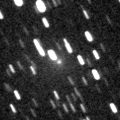
|
Now it is 15.1 mag (Apr. 3, Ken-ichi Kadota). It has a very faint large coma. It was observed so bright as 13.5 mag in January (Jan. 16, Michael Jager).
Date(TT) R.A. (2000) Decl. Delta r Elong. m1 Best Time(A, h)
Apr. 17 5 30.50 76 26.1 1.412 1.469 72 15.4 18:58 (169,-25)
Apr. 24 7 12.22 75 54.8 1.414 1.499 74 15.5 18:50 (174,-22)
|

|
Now it is 15.3 mag (Mar. 26, P. Concari, S. Foglia, G. Galli, M. Tombelli). It was observed as 15-16 mag in early 2009. In 2010, it will be observable at 16 mag in good condition from winter to spring.
Date(TT) R.A. (2000) Decl. Delta r Elong. m1 Best Time(A, h)
Apr. 17 13 39.24 -2 31.8 2.672 3.669 172 15.4 0:01 (180, 58)
Apr. 24 13 34.83 -2 14.4 2.688 3.675 167 15.5 23:24 (180, 57)
|
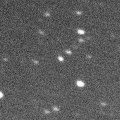
|
Now it is 15.6 mag (Apr. 11, John Drummond). It keeps bright as 14-15 mag for a long time after this until 2013. It is observable in good condition in the Southern Hemisphere. However, it is not observable in the Northern Hemisphere.
Date(TT) R.A. (2000) Decl. Delta r Elong. m1 Best Time(A, h)
Apr. 17 15 38.09 -46 9.5 6.305 7.063 136 15.5 2:00 ( 0, 79)
Apr. 24 15 32.58 -46 43.0 6.219 7.033 141 15.4 1:27 ( 0, 78)
|

|
It became visible visually at 13.3 mag in winter (Feb. 3, Marco Goiato). Now it is fading slowly. It will be getting lower in the evening sky after this. It will be too low to observe in July.
Date(TT) R.A. (2000) Decl. Delta r Elong. m1 Best Time(A, h)
Apr. 17 6 47.67 24 40.2 1.893 1.884 74 15.5 18:58 (152, 25)
Apr. 24 7 4.23 24 41.3 1.954 1.884 71 15.5 18:50 (152, 25)
|
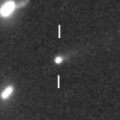
|
Now it is 15.6 mag (Mar. 17, Toshiyuki Takahashi). It was expected to be observable at 15 mag in good condition from winter to spring. But actually, it had been much fainter than expected until January. However, it is brightening very rapidly in February.
Date(TT) R.A. (2000) Decl. Delta r Elong. m1 Best Time(A, h)
Apr. 17 10 10.67 20 38.2 1.565 2.244 120 15.5 20:29 (180, 34)
Apr. 24 10 14.29 19 50.9 1.635 2.247 114 15.6 20:05 (180, 35)
|

|
It brightened up to 11.5 mag in January (Jan. 12, Juan Jose Gonzalez). It is still bright as 13.1 mag (Mar. 13, Carlos Labordena). It will be getting fainter and lower rapidly after this. It will be unobservable in June.
Date(TT) R.A. (2000) Decl. Delta r Elong. m1 Best Time(A, h)
Apr. 17 7 18.04 19 44.8 2.051 2.147 81 15.7 18:58 (158, 32)
Apr. 24 7 31.17 19 44.9 2.145 2.168 77 15.9 18:50 (156, 31)
|
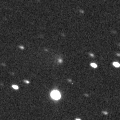
|
Brightening more slowly than expected. It will be observable at 13-14 mag for a long time from 2011 to 2012. It is getting higher gradually after this. In 2010, it is observable at 15-16 mag in good condition from spring to autumn.
Date(TT) R.A. (2000) Decl. Delta r Elong. m1 Best Time(A, h)
Apr. 17 22 0.29 1 3.1 7.939 7.412 55 16.0 5:00 (244, 31)
Apr. 24 22 0.52 1 16.7 7.801 7.377 61 16.0 5:05 (236, 36)
|

|
It brightened up to 13 mag and observed visually from 2007 to 2009. Due to the far distance, it is bright as 14.8 mag still now (Apr. 7, E. Bryssinck, A. Novichonok, D. Chestnov, L. Elenin). It will be observable in good condition again until spring.
Date(TT) R.A. (2000) Decl. Delta r Elong. m1 Best Time(A, h)
Apr. 17 12 12.33 43 0.1 7.435 8.027 123 16.4 22:30 (180, 12)
Apr. 24 12 6.22 42 58.6 7.539 8.061 118 16.5 21:56 (180, 12)
|
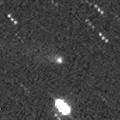
|
Now it is 17.2 mag (Apr. 4, Ken-ichi Kadota). It keeps observable in good condition for a while, but it will be fading after this. It will be fainter than 18 mag in July.
Date(TT) R.A. (2000) Decl. Delta r Elong. m1 Best Time(A, h)
Apr. 17 13 4.00 28 36.4 2.625 3.456 140 16.6 23:20 (180, 27)
Apr. 24 12 47.64 27 47.5 2.709 3.497 135 16.7 22:36 (180, 27)
|

|
It reached up to 15.1 mag on Mar. 10 (Hidetaka Sato). It brightened up to 11 mag in outburst in 2003. However, it did not become so bright in this apparition. Now it is 16.5 mag (Apr. 9, Hidetaka Sato). It will be getting lower and fainter rapidly after this. It will be fainter than 18 mag in May.
Date(TT) R.A. (2000) Decl. Delta r Elong. m1 Best Time(A, h)
Apr. 17 6 8.94 22 17.8 1.606 1.497 65 16.6 18:58 (143, 23)
Apr. 24 6 33.34 21 36.2 1.672 1.530 64 16.8 18:50 (143, 24)
|

|
It brightned up to 10 mag from late 2008 to early 2009. Now it is fading. It has already faded down to 16.9 mag (Mar. 13, Ken-ichi Kadota). It will be fainter than 18 mag in June.
Date(TT) R.A. (2000) Decl. Delta r Elong. m1 Best Time(A, h)
Apr. 17 9 37.75 4 5.1 5.587 6.125 118 17.2 19:56 (180, 51)
Apr. 24 9 37.40 4 4.7 5.741 6.179 111 17.3 19:28 (180, 51)
|

|
It was observed at 17.5 mag in 2009 spring. It will be observable at 17.5 mag again in 2010 spring. However, it locates low in the Northern Hemisphere.
Date(TT) R.A. (2000) Decl. Delta r Elong. m1 Best Time(A, h)
Apr. 17 13 38.46 -20 0.7 4.982 5.974 170 17.2 0:00 (180, 75)
Apr. 24 13 35.69 -19 1.5 4.989 5.983 170 17.3 23:25 (180, 74)
|

|
It brightened up to 13 mag in major outburst in 2005. It was recovered at 20.7 mag in 2009 January. However, no observations have been reported after 2009 April. The current brightness is quite uncertain.
Date(TT) R.A. (2000) Decl. Delta r Elong. m1 Best Time(A, h)
Apr. 17 13 9.76 -22 25.2 2.392 3.375 165 17.3 23:27 (180, 77)
Apr. 24 13 4.02 -21 55.6 2.376 3.350 162 17.3 22:54 (180, 77)
|
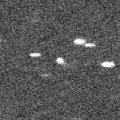
|
Now it is 17.7 mag (Mar. 21, Hidetaka Sato). It will reach up to 17 mag in spring and summer.
Date(TT) R.A. (2000) Decl. Delta r Elong. m1 Best Time(A, h)
Apr. 17 20 52.05 -2 50.9 3.469 3.311 72 17.4 5:00 (231, 46)
Apr. 24 20 56.92 -3 31.6 3.380 3.325 78 17.4 5:05 (224, 50)
|

|
Now it is 17.4 mag (Feb. 17, Hidetaka Sato). It will be fainter than 18 mag in July.
Date(TT) R.A. (2000) Decl. Delta r Elong. m1 Best Time(A, h)
Apr. 17 19 1.03 37 45.6 6.511 6.607 91 17.4 5:00 (184, 17)
Apr. 24 19 1.18 38 39.9 6.508 6.657 94 17.4 4:54 (180, 16)
|
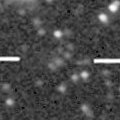
|
Now it is 17.3 mag (Jan. 23, Ken-ichi Kadota). It keeps observable at 17.5 mag in good condition for a long time in 2010.
Date(TT) R.A. (2000) Decl. Delta r Elong. m1 Best Time(A, h)
Apr. 17 23 18.80 74 20.0 5.145 4.843 67 17.4 5:00 (197,-28)
Apr. 24 23 20.81 75 31.0 5.153 4.843 66 17.4 5:05 (194,-27)
|
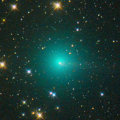
|
It brightened up to 6.7 mag in 2009 June (June 9, Marco Goiato). Now it is fading. It has already faded down to 17.5 mag (Mar. 31, Hidetaka Sato). It will be fainter than 18 mag in May.
Date(TT) R.A. (2000) Decl. Delta r Elong. m1 Best Time(A, h)
Apr. 17 10 5.45 56 49.0 3.601 3.900 99 17.6 20:23 (180, -2)
Apr. 24 9 55.21 56 8.9 3.766 3.963 93 17.8 19:45 (180, -1)
|

|
Now it is observable at 17.5 mag in good condition. However, it will be fainter than 18 mag in May.
Date(TT) R.A. (2000) Decl. Delta r Elong. m1 Best Time(A, h)
Apr. 17 11 28.60 -1 26.2 1.860 2.753 146 17.7 21:46 (180, 56)
Apr. 24 11 27.60 -0 47.9 1.915 2.755 139 17.8 21:18 (180, 56)
|

|
New periodic comet which brightened up to 14 mag in 2004 and 2005. It should be observable at 18 mag also around the aphelion. However, no observations have been reported since 2008 January. It seems to have faded out rapidly. Now it is fainter than 20.4 mag actually (Sept. 16, Leonid Elenin).
Date(TT) R.A. (2000) Decl. Delta r Elong. m1 Best Time(A, h)
Apr. 17 6 30.63 30 48.6 5.096 4.846 70 20.4 18:58 (151, 18)
Apr. 24 6 35.21 30 43.9 5.187 4.836 64 20.4 18:50 (148, 16)
|
|
![]()
 C/2006 W3 ( Christensen )
C/2006 W3 ( Christensen ) C/2007 Q3 ( Siding Spring )
C/2007 Q3 ( Siding Spring ) C/2010 F4 ( Machholz )
C/2010 F4 ( Machholz ) 10P/Tempel 2
10P/Tempel 2 P/2010 H2
P/2010 H2 C/2009 O2 ( Catalina )
C/2009 O2 ( Catalina ) 43P/Wolf-Harrington
43P/Wolf-Harrington 65P/Gunn
65P/Gunn 29P/Schwassmann-Wachmann 1
29P/Schwassmann-Wachmann 1 C/2010 G1 ( Boattini )
C/2010 G1 ( Boattini ) 126P/IRAS
126P/IRAS P/2010 A5 ( LINEAR )
P/2010 A5 ( LINEAR ) 141P/Machholz 2
141P/Machholz 2 104P/Kowal 2
104P/Kowal 2 116P/Wild 4
116P/Wild 4 P/2010 A3 ( Hill )
P/2010 A3 ( Hill ) C/2008 FK75 ( Lemmon-Siding Spring )
C/2008 FK75 ( Lemmon-Siding Spring ) C/2009 U3 ( Hill )
C/2009 U3 ( Hill ) 74P/Smirnova-Chernykh
74P/Smirnova-Chernykh C/2009 F4 ( McNaught )
C/2009 F4 ( McNaught ) 30P/Reinmuth 1
30P/Reinmuth 1 94P/Russell 4
94P/Russell 4 118P/Shoemaker-Levy 4
118P/Shoemaker-Levy 4 C/2006 S3 ( LONEOS )
C/2006 S3 ( LONEOS ) C/2005 L3 ( McNaught )
C/2005 L3 ( McNaught ) C/2008 N1 ( Holmes )
C/2008 N1 ( Holmes ) 157P/Tritton
157P/Tritton C/2006 OF2 ( Broughton )
C/2006 OF2 ( Broughton ) C/2009 F2 ( McNaught )
C/2009 F2 ( McNaught ) 213P/2009 B3 ( Van Ness )
213P/2009 B3 ( Van Ness ) C/2009 K2 ( Catalina )
C/2009 K2 ( Catalina ) C/2006 Q1 ( McNaught )
C/2006 Q1 ( McNaught ) C/2007 VO53 ( Spacewatch )
C/2007 VO53 ( Spacewatch ) C/2008 Q3 ( Garradd )
C/2008 Q3 ( Garradd ) 235P/2010 F2 ( LINEAR )
235P/2010 F2 ( LINEAR ) P/2004 F3 ( NEAT )
P/2004 F3 ( NEAT )![]()

































